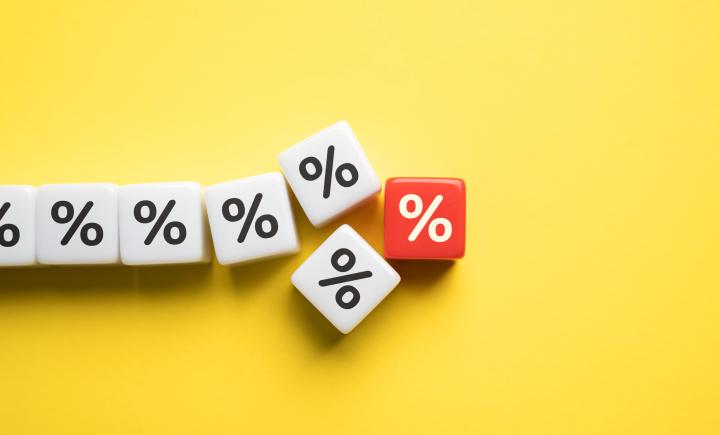Growing income inequality leads to lower interest rates and higher household debt


My research focuses on the “natural interest rate”, i.e. the real interest rate (the nominal interest rate less inflation) which corresponds to a situation in which aggregate demand is equal to the aggregate productive capacity of an economy, and inflation is in line with the objective set by the central bank. Previous studies have shown a decline in the natural interest rate in advanced economies. The red line in Figure 1 illustrates this finding for the United States, the country whose data I used for my research.
What role does heightened inequality play here? Empirical studies show that when more affluent households see their income increase, they save a larger share of that increase than less affluent households, even if they expect the increase to be permanent. Hence if the income of the wealthiest 10% of households rises at the exponse of the bottom 90%, total consumption in the economy falls. The reason for this is that the increase in consumption by the wealthiest 10% does not offset a drop in consumption by the remaining 90% of households.
To prevent aggregate demand from falling below productive capacity, a lower real interest rate is thus necessary. In other words, the natural interest rate declines. Consequently, since a level of output below productive capacity tends to reduce inflation, the central bank will sooner or later align the real interest rate to the now reduced natural interest rate. This reduction in the real interest rate will curb the tendency to save on the part of the wealthiest households and encourage the bottom 90% to temporarily maintain consumption at a level above their – now lower – income, by borrowing more. A portion of the additional savings by the wealthiest 10% of households thus finances the loans the bottom 90% will take out.
A portion of additional savings by the wealthiest 10% of households finances borrowing by the bottom 90%.
A macroeconomic model that replicates the fall in the natural interest rate …
To examine the validity of this reasoning, I developed a macroeconomic model that captures these mechanisms and can therefore be used to test if they can explain the trends observed in the data. A macroeconomic model is a mathematical representation of the economy that describes the behaviour of households and businesses. It thus facilitates study of the effect of various behaviourial assumptions and changes in the economy.
For example, in this model, the reason affluent households have a tendency to save a larger share of their permanently increasing income is that they wish to accumulate wealth for its own sake (the “spirit of capitalism”, as Max Weber suggests). Therefore, they do not save merely for the purpose of future consumption, in which case they would consume more but not save more following a sustained increase in their income. Without the assumption of a capitalist spirit motive, it is difficult to rationalize this pattern and other aspects of their saving behaviour.
In order to verify if the mechanisms of the model help to explain the downward trend in the natural interest rate, I fed the empirically observed increase in income inequality in the United States into the model. Between 1980 and 2000, this growth in inequality can be explained by a relative increase in the wages of the most affluent 10% of households compared to those of the bottom 90%. Since 2000, rising corporate profits are the main driver of this phenomenon, which the model captures as an increase in market power. Greater market power allows companies to raise prices above their costs per unit of output.
Figure 1 shows that the model largely succeeds in reproducing the decline in the natural interest rate since 1980 (comparison of the dotted black line with the red line). In particular, the simulation captures the decline attributable - according to these estimates - to negative "demand shocks" (the solid black line). These are shocks that reduce household and business spending, assuming all other parameters remain unchanged. For example, less favourable productivity growth forecasts drag down the red line but not the black line, as they also influence the supply side of the economy.
… as well as the observed increase in household debt …
Furthermore, the model can explain other important empirical trends. Figure 2 shows that the model replicates the growing trend in indebtedness of the bottom 90% of households. As mentioned above, the model attributes the increase in borrowing by these households to the fall in the real interest rate. The latter is explained in turn by an increase in savings on the part of more affluent households, which thus finance spending by households with lower income.

… and finally the rise in housing prices
The model also replicates the finding that housing prices grew faster than nominal incomes between 1980 and 2016. Indeed, according to the model, the decline in interest rates pushed up household demand for housing more than for other items. The ability of the model to capture the rise in the empirical value of housing improves if the behaviour of the bottom 90% of households is adjusted based on the assumption that they strive to imitate the consumption on that of the top 10%. This is referred to as trickle-down consumption. Specifically, I assume that the bottom 90%’s demand for housing is positively correlated with the consumption of the top decile of households, which is consistent with previously established microeconomic observations. When this assumption is incorporated into the model, the increase in the value of housing stock it simulates becomes much more substantial, with the indebtedness of the bottom 90% of households also increasing somewhat.
Interest rates have risen over the past few months. However, the foregoing analysis suggests that they may remain relatively low as income distribution tends to change slowly. Provided fiscal and tax policies are effective in changing income distribution, the former could play an important role in determining interest rates and the overall level of household debt in the economy.






